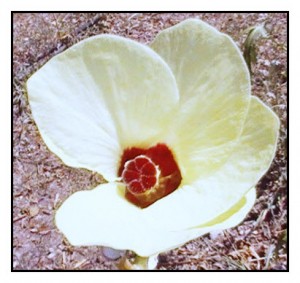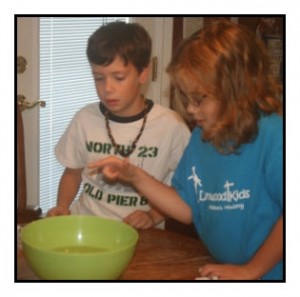Introduction to the Science At Home Series:
Project 1: Fun With Water
Investigation: The Blooming of a Paper Flower
 Andrea Roseman, a homeschooling mom with two lovely children, tested this experiment and posted comments on her website, WhatEverPhilippians48. Andrea and I exchanged ideas and with her approval, I have included her hints, clues, and suggestions to make this activity more homeschool friendly. Thanks Andrea!
Andrea Roseman, a homeschooling mom with two lovely children, tested this experiment and posted comments on her website, WhatEverPhilippians48. Andrea and I exchanged ideas and with her approval, I have included her hints, clues, and suggestions to make this activity more homeschool friendly. Thanks Andrea!
What is an Exploratory Investigation?
An exploratory investigation is performed for the purpose of discovery. Another way to describe an exploratory investigation is that it is a type of research.
There should be no specific limits or procedure steps when one is investigating. In other words, during an exploratory investigation, you can use any or all the fundamental steps of the scientific method.
An exploratory investigation can be an experiment, a model, or a collection. The purpose of an exploratory investigation is discovery of information about some phenomenon. (Phenomenon: A fact or situation that is observed to exist or happen, especially one whose cause or explanation is in question).
Always keep in mind that even though an exploratory investigation can be a “tinkering around” type of fact-finding, always k eep details notes of everything about your process and data collected. One never knows when some “tinkering around” investigation will uncover something very useful. Sometime life-changing discoveries are serendipitous —meaning they happened without being planned. Sir Alexander Fleming, (6 August 1881 – 11 March 1955
eep details notes of everything about your process and data collected. One never knows when some “tinkering around” investigation will uncover something very useful. Sometime life-changing discoveries are serendipitous —meaning they happened without being planned. Sir Alexander Fleming, (6 August 1881 – 11 March 1955
Example Exploratory Investigation: Absorption
Teaching Tip: Introduce the idea of variables.[A variable is anything that affects the results of an experiment.] Direct students to use an eyedropper to place 1-2 drops of colored water on a piece of paper towel. Observe the movement of the colored water through the paper.
Challenge: The type of paper used is a variable.
Does the type of paper affect how the colored water moves through the paper? Provide samples of different types of paper so students can repeat the procedure. Ask them to use their data (results of each experiment) to write a simple conclusion about their exploratory investigation, aka “tinkering around ” to find out what happens when water drops fall on different types of paper.
Now kids understand that paper towels absorb water because they are so porous, but thick enough not to fall apart like toilet paper.
Exploratory Investigation: Force
Paper is made of tiny fibers from plants. These fibers overlap and some create channels through which water can flow. Thus, the drops of colored water in the previous investigation was able to flow through these fiber-channels.
Purpose: If paper is folded, can absorbed water flowing through the paper force the paper to unfold?
Prepare folded papers for each student. I suggest you use newspaper and a flower pattern. The diagram shows to overlap the folded petals.
Tips for preparing the paper flowers
1. Draw a four petal flower on a 4 inch square piece of card-stock or other stiff paper. Cut out the pattern. Place the flower pattern on top of several sheets of newspaper. Trace around the pattern and then cut out the shape by cutting through all the paper layers.
2. Fold each of the paper flowers as shown in the diagram with the petals overlapping each other.
1. For each child, cut 3 or more four-leaf flowers from newspaper.
By preparing the first paper flowers used by students l, you are controlling these variables. size, shape, and material of the flowers. Any part of the investigation that could affect the results is called a variable. It’s not time to talk about variables, I just wanted you to introduce the term here. The variables so far could be the size, number of petals, shape, type of paper and even how you cut them, such as using pinking shears or straight edge scissors.
2. Pre-fold each of the paper flowers following the diagrams shown. Make an effort to crease each fold the same–not too tight, but not too loose. You want the papers to stay folded with one petal laying on top of the other.
How tightly the petals are creased could affect the results of the experiment, so creasing is a variable. Thus make an effort to crease all the petals the same.
 3. The folded flowers are to be dropped into water. Use a container that has a diameter at least twice that of the flowers. Paper or Styrofoam saucers work well.
3. The folded flowers are to be dropped into water. Use a container that has a diameter at least twice that of the flowers. Paper or Styrofoam saucers work well.
You want the flowers to have space to open. OOPS!! I just told you the results. While you will know the results don’t give any clues to your students about what is going to happen. In fact, the experiment works best if the kids do not see you prepare the flowers in advance. Hand out the flowers and the dry folded flowers. Ask students not to unfold the papers.
4. It is important that the folded flower lands in the water petal side up. Ask student to practice dropping the folded paper with the flat side down and overlapping parts up. Tell them the folded paper will be dropped into water in their saucer. It is an amazing results so it would be great if everyone dropped their paper at the same time. Maybe—Ready Set Go!
5. Now add about 1 inch of cold tap water to the saucers. Point out that not even a drop of water is to get on the paper.
Get Ready!
Set!
G0!
All the paper should be dropped into the saucers of water.
Results————-The paper flower petals open one at a time.
Results: The results of any experiments depends on variables.
Why? When paper absorbs water it swells. st the paper swells along the creases of the folded petal, the petals are forced to unfold.
Now for extending the experiment by considering variables. This is a good time to introduce expressing science questions that identify variables that might affect the experimental results.
A question for an Experimental Investigation should identify two variables. When possible, the variables should be measurable.
For this experiment how fast the petals open could be measured using a stop watch.
Variables to consider that might affect how fast the folded paper are:
1. Type of paper
2. Shape of paper–
How does the shape of the paper affect the opening speed its folded parts?
This is a cause and effect question. You want to find out if shape causes the speed of the the folded paper to open faster.
Cause: shape —Also called the independent variable
Effect: opening speed—Also called the dependent variable
While there is no one form for writing an experimental question, the following example basically works for this investigation. The blank is where one of the previously identified variables would be inserted.
How does ______ affect the OPENING SPEED of the folded parts?
(1.) How does the paper’s shape affect the OPENING SPEED of the folded parts?
(2.) How does the paper’s size affect the OPENING SPEED of the folded parts?
(3.) How does water temperature affect the Opening SPEED of the folded parts?
(4) How does the type of paper affect the OPENING SPEED of the folded parts?
ETC……………………
Remember—Test one variable at a time and have only one resulting variable you are observing. If you change the shape and size of the paper and the opening speed changed, you would not be able to identify the variable that caused the change.
Again—Test one variable at a time and keep all the other variables constant.
The Experimental Control is your standard. In other words, if you change the shape of the paper, you will decide if this new shape opens faster, the same, or slower than the control paper flower (the original flower for the EXPLORATORY INVESTIGATION.
Hypothesis: After completing the exploratory investigation you know what is going to happen and why. You know enough to give a prediction. For example, if the experimental question is:
What effect does the size of the paper have on the open speed of the folded parts? or
How does the size of the paper affect the opening speed of the folded parts?
Hypothesis: Remember that a hypothesis is not a wild guess. In fact, some explanation should be given. Examples:
For young children, help them express their hypothesis. Do this by giving clues–hints–nudging-type questions. Also, help them to remember why the paper unfolds.
If the paper is opening because it is absorbing water, I wonder…Would it take longer for a big piece of paper to absorb enough water to open its folded petals?
What do you think…If the paper flower is larger, will the folded petals open faster? slower? or the same as the small flower?
For older children, guide them to express hypothesis such as these:
If it takes more time for a large paper to absorb water, then an increase in the flower’s size decreases the opening speed of its folded parts.
If an increase in size increases water absorbing time, then as the paper flower’s size increases the opening time of its folded parts decreases.
A hypothesis is the statement that is used to design an experiment. For this hypothesis, you want to do TESTS— yes! more than one. Using the same shape, the same kind of paper, same water temperature, the same—EVERYTHING must be the same expect for the size of the flower. One way to keep the shape the same would be to increase the size via your computer–then print out the patterns. I have done this for you. Print a copy,then cut out the Different Sized Paper Flower Patterns. Use these to cut different sizes of paper flowers from newspaper.
Experiment:
Using the same basic procedure as the control experiment, test your different paper flower sizes. Determine how to measure the opening time for the folded parts.
I am anxious to hear from you. Tell me if you got bogged down anywhere. Are there parts that need more explanation? Is it too complicated? I ask these things because I get so frustrated with tutorials about website coding. The author assumes that I know much more about computers than I do. Every teacher should take some course that they know nothing about so they can be empathetic with kids that are learning new terms.
Share with me what variables you tested and your results. Do you have some special way to record your data (results–measurements–observations–etc–from an experiment)? What were your conclusions for the experiments?

